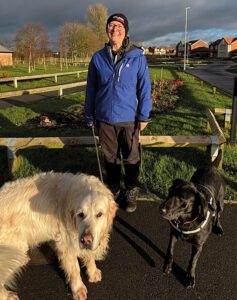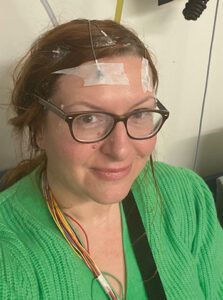 “I didn’t know where I was,” explains Nic. “I know I was in a train station, but I didn’t know which part of the country, I didn’t know what train I needed to get on.”
“I didn’t know where I was,” explains Nic. “I know I was in a train station, but I didn’t know which part of the country, I didn’t know what train I needed to get on.”
Nicola (Nic) Adamson, a recently appointed Epilepsy Action trustee, has had epilepsy for over 10 years. In that time, Nicola says she’s tried about 10 different medications but none have been able to control her seizures, which she explains tend to come in clusters. In September 2024, she went 10 days without a seizure, but she had 21 focal seizures overall. “That’s very normal for me,” she says.
Having experienced a range of different types of seizures, the focal seizures are the ones that Nic says have been the worst for her. “If I have a tonic-clonic seizure, I don’t know about it. I’m unconscious. They don’t bother me. Afterwards the recovery bothers me. The actual seizure itself is very difficult for those around me, but for me, it doesn’t bother me at all.
“Whereas some of the focal seizures that nobody can tell I’m having, except for my close family – they’re really unpleasant.”
Trouble at the station
At the time when she found herself in trouble at a train station, Nic was working in the NHS in a senior position, commissioning specialised (rare) services. While this started out as a job she could do working from home, it quickly turned into one where she was asked to travel to London for three or four days a week and staying overnight in hotels.
“At first, I used to travel everywhere on my own,” Nic explains. “Then, I had one day when I was down in London for work and I’d had quite a bad seizure. Not long after that, I’d had a really bad day of seizures.
“A colleague went with me on the tube to Euston station. Then, me being me, I told them that I’d be fine from there. But I kept having lots of focal seizures and I got really confused.
 “I ended up managing to speak to my husband, Jay, on the phone – I managed to ring him between seizures. It was awful for him, because he knew I was having seizures in between while he was on the phone to me.
“I ended up managing to speak to my husband, Jay, on the phone – I managed to ring him between seizures. It was awful for him, because he knew I was having seizures in between while he was on the phone to me.
“He was trying to explain to me where I was and what was going on and to go and get help. He told me to buy a ticket for an earlier train and that he’d meet me on the other end in Preston. He told me to find a member of staff and try to get help, but I think the staff just thought I was drunk. I was confused and was really struggling to talk properly and get my words out.
“When I went to pay for the ticket, I couldn’t remember my pin number – this was before Apple Pay, which is a lifesaver for me now! Eventually, I managed to buy a ticket, but by the time I’d bought it, I ended up missing the train anyway.
“Experiences like that – and that’s just one of many really – mean that now I’m quite anxious about even just getting the bus on my own, in case I have a cluster of seizures because I don’t know where I am.”
Life-changing condition
The reality of living with uncontrolled seizures has had quite a profound impact on Nic’s life, including disrupting her independence and having to give up a beloved job.
She explains: “Obviously, I’ve not driven now for over 10 years. Not being able to just get in the car and pop to the shops is hard.
“If I’m on public transport, I tend to always have someone travelling with me. This keeps me quite isolated at home.”
One thing Nic still feels up to doing is taking her golden retriever Murphy and her black labrador Layla for a walk. And even then, she sometimes has to rely on the goodness of acquaintances if she feels like a seizure is coming on.
“On days I don’t have seizures, I get out for a good three or four-mile walk with the dogs. I go the same route every time, so it’s very familiar. And I see all the same people each time. If I feel unwell and like I’m going to have a seizure, I just sit on the floor and they just sit with me until I’m feeling okay again. Thankfully we don’t need to do that very often.”
But even with all these challenges, giving up work has been one of the most difficult parts for Nic.
 “I knew I’d got to a point where I was just having too many focal seizures at work and the tiredness of everything that was coming with that was becoming really difficult to manage. I never took time off sick, I always just used to carry on working through them. But obviously, it was the wrong thing to do. I wasn’t looking after myself properly.”
“I knew I’d got to a point where I was just having too many focal seizures at work and the tiredness of everything that was coming with that was becoming really difficult to manage. I never took time off sick, I always just used to carry on working through them. But obviously, it was the wrong thing to do. I wasn’t looking after myself properly.”
With this difficult decision, however, came a ray of hope. Nic had had a video EEG which showed that her seizures were coming from the left side of her brain. While she was working, she was told that operating on the left side of the brain was very high risk, as it could affect her speech and other brain functions. Now, surgery became a possibility for her.
One of the reasons it is really important for doctors to find a way to control Nic’s seizures is the progression to tonic-clonic seizures, some lasting more than five minutes and some occurring in clusters, which comes with its own serious risks.
The next step for Nic is to have Stereoelectroencephalography (SEEG), due to take place this year. This is an EEG where electrodes are placed deeper into the brain to try to try to get a more precise picture of exactly where the seizures are starting from. This will help inform if she would be a candidate for epilepsy surgery.
Nic will share her experiences of this surgery once it has been done.
This May, we’re sharing as any people’s stories as we can. Do you want to share your epilepsy story? Just fill out our Share Your Story form.

Share your story
Help us to spread the word by signing up below to be a story champion.




